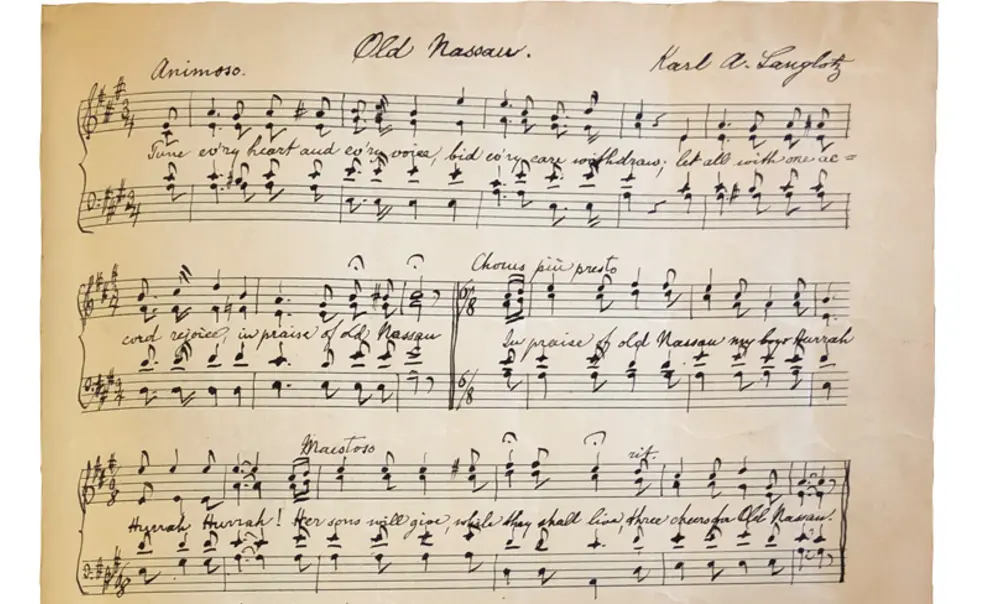After a Golden Age for College Songs, Their Popularity Declined. Why?
College songs rose in prominence along with our modern idea of college life
Traditions, too, have beginnings and ends. Once, graduating classes at Princeton selected, along with a valedictorian and salutatorian, a “class prophet”: a far-seeing student whose job it was to deliver a prognostication for each of the class’s members. Once, they planted ivy at the base of Nassau Hall, marked with plaques bearing class numerals; today, Nassau Hall is thoroughly ivied and filled with plaques, so classes plant stones along the walkway. And once, graduating classes knew by heart a whole compendium of school songs: not just “Old Nassau,” which is the official school anthem and thus obligatory for alums to know, but songs like “New Jersee,” “Here’s to the Campus,” and “Going Back to Nassau Hall” — the last of which remains a standard among older classes, but not among the youngest generations of Tigers.
Why did the college song decline? In their early years, colleges like Princeton looked with suspicion on any singing that wasn’t religious, according to J. Lloyd Winstead, a historian of college singing. (The school’s strict religiosity endured for a long age. A line from a lecture in moral philosophy at Princeton, in 1858: “All men ... are possessed of redeeming characteristics, that at times will gild the black recesses of the heart, and relieve the sickening monotony of entire moral desolation.”)
Slowly, the College of New Jersey, as Princeton was then known, softened on singing enough to let students start singing clubs — moved first by a zeal for patriotic songs during the years around the Revolutionary War, then by a 19th-century vogue for German musical culture. In the 1850s, Karl Langlotz, a German immigrant who taught fencing at the College, started a singing club for students, “The Nassau Maennerchor.” (He composed the music for “Old Nassau,” which one of his students wrote.) Students formed quartets, the ancestors of campus a cappella. In 1874, students founded the Glee Club.
In 1869, Princeton played the first-ever college football game, against Rutgers. Soon, football was a major part of college life nationwide, with roaring fans breathing new life into the college song. Before, college songs often toasted revelry, with lyrics like “beams divine through the liquor shine.” Now, they cheered athletic contests with lyrics like “fight, fight, fight” and “be loyal and true” — as the songwriter Kenneth Clark 1905 later wrote in the Saturday Evening Post.
When the Nassau Literary Magazine reported on football games, it reported on the songs in the stands, too, as if they were just as important as the action on the field. They required just as much stamina, apparently; after one game, the Lit noted, “Even the rousing strains of Old Nassau have lost much of their impressiveness by the eighth or ninth repetition in a single afternoon, proceeding as they do, from croaking and exhausted throats.” Before big games students gathered around the cannon to rehearse fight songs. When Princeton played games in New York City, bars and hotels gave their pianists sheet music for Princeton songs like “Old Nassau,” hoping to lure students and alumni.
The golden age of the college song coincided not just with the rise of college football, but with the rise of our modern idea of college life. Between 1880 and 1920, many schools, including Princeton, adopted mascots, school colors, and other displays of school spirit. Singing honored that spirit. In a 1912 book about college life, the author Clayton Sedgwick Cooper argued that singing held a greater spiritual resonance for students than chapel exercises. “Dr. Henry van Dyke,” he wrote of a Princeton professor, “has said that the college man’s songs and yells are his prayers. He is not the first one who has felt this in listening to Princeton seniors on the steps of Nassau Hall singing that thrilling hymn of loyalty, ‘Old Nassau.’”
And yet a golden age is always the beginning of the end. Clark wrote his article for the Post about the triumph of the college song, but he could already tell, in 1934, that it was a fading form. He suggested several reasons why. Musical tastes were changing, with jazz and Bing Crosby-style crooning replacing peppy choruses; technology was changing, with radio and vinyl replacing live music. Campuses didn’t stand still, either. A Princeton songbook from 1890, Carmina Princetoniana, refers to all kinds of experiences that Princetonians no longer have, from smoking pipes to roaming the town at night: “Arm in arm together, boys! We’ve wandered through the night … / Ready for a serenade, a horn-spree or a fight … .” The old songs became less relatable as the times changed.
And the times kept changing. Every class that went through Princeton has its own Proustian madeleines, auditory or otherwise. Mine are from the post-9/11 years. Triangle songs with hooks riffing on current events, like “Weapons of Mass Distraction.” Maroon 5’s album Songs About Jane, which floated from dorm windows, while weekend parties on Prospect Avenue pulsed with synth-heavy hip-hop and pop songs protesting the war on terror. The aroma of Milwaukee’s Best, or “Beast,” which was, when I was a student, the cheapest beer available and therefore what flowed from the taps at eating clubs, and which, a friend of mine once said, “smells like patriotism and regret.”
But the campus also has a soundtrack that endures across the generations. Insects singing in the crowns of trees; the rustling whisper of the rare books room; the melting notes of arch sings; the dulcet tones of professorial voices floating out of the lecture hall. Will Howarth once told me that when he was a lowly assistant professor, approaching his tenure review, a senior faculty member appeared at one of his lectures and sat in the back, listening. Afterward, he came up to the nervous young professor and said simply, “You have pear-shaped tones.” Howarth never figured out what that meant, but he got tenure.
And so the singing faded, the singing endures. Those wordless hymns stay with the students — whom Ralph Adams Cram, the architect who designed Princeton’s campus, called the “College Militant” — and the alumni, the “College Triumphant.” When we gather, once a year, in the sweet hereafter of Reunions, we raise all our voices in harmony, sometimes to sing the old songs, or their best refrains — “Old Nassau” has five verses, but we find it convenient to remember just one — and sometimes just to add, once more, to the familiar din of the campus. Traditions come and go, but the place we sing about remains. As does its own kind of music.












4 Responses
Ellis P. Waller ’59
7 Months AgoBagpipe Music for Princeton Tunes
For many years our class of 1959 has hired the Kiltie Band of York, Pennsylvania, to accompany us in the P-rade. I was fortunate to be invited to play my bagpipes with them as they marched at our last reunion. I asked if the band could play any of Princeton’s well known tunes and the answer was no. Returning home to Wisconsin, I transposed to the bagpipes “Going Back to Nassau Hall,” “The Princeton Canon Song,” and “Old Nassau.” I gave these to the band and also sent copies to the Firestone/Mudd music library. I hope they are still there (my thesis was stolen). If there are any pipers who want copies of these tunes, I will gladly send them to you.
Jay Kerr ’67
7 Months AgoCarrying the College Song Forward
I would have liked to hear about more recent editions of Carmina. I know there was one as late as the 1960s. And how about Drew Fornarola ’06’s “Orange Bubble,” from early 2000s Triangle? His generation’s take on the College Song. A great idea for an article that could have used a few more minutes of research and input from campus musicians and musical groups.
Robert Mohan ’26
7 Months AgoA Cappella Helps Keep Traditional Tunes Alive
Thank you for memorializing our campus songs through this informative article! As the undergrad president of the Nassoons, I’d be remiss not to add that we still sing many of the songs mentioned here. We love singing “Old Nassau,” “The Orange and the Black,” “Our Lofty Elms,” “Drawn By Allegiance,” “Going Back to Nassau Hall,” and “Come Ye Men of Princeton” each year. We have a copy of the 1890 Carmina Princetonia that you referenced, and our active repertoire regularly draws from it. This isn’t meant to be self-promotional in the slightest, but I thought it was worth noting that current undergrads are passionate about the tradition of collegiate singing, and Princeton’s a cappella scene keeps the legacy alive today.
Betsy Gain ’92
7 Months Ago‘Black and Orange Me’
Thank you for writing this. I’ll tell you the sad sad story about the song I wrote years ago for a group of friends who sometimes sang corny songs at infrequent gatherings. It’s a tiger song to give non-tiger spouses a musical identity, but it’s suitable for alumni too. After I wrote it, life happened and the group stopped gathering, so it was never sung. The song lay dormant for years. It was fading into oblivion until I decided to record it for my 20th reunion. It now lives on BandCamp, and there’s a copy of the sheet music in the Princetoniana collection in Firestone. I’ve been sharing it every year around Reunions, and it gets a smattering of appreciation. It is a good song. But mostly it doesn’t matter and I feel like a lunatic for having written something that people don’t want. Maybe people don’t want songs like this to be written by someone who is still alive, or maybe they don’t want them to be written by a woman. Maybe they just don’t want songs like this. :’(
Here’s a link if you’d like to hear “Black and Orange Me”; I also made this YouTube video to help people learn the words.